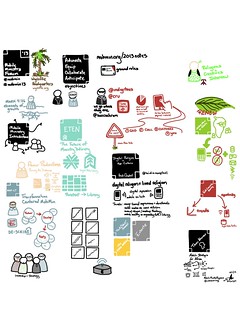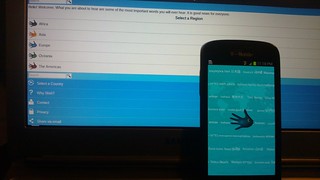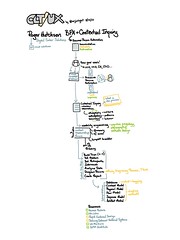Welcome to a refreshed Mobile Ministry Magazine (MMM). Starting this year, we are going back to the simplicity of the issue format. Each month we will be hitting on those points where you can discover, observe, relate, or be released into mobile ministry (#mobmin) efforts. It’s a packed issue, let’s get into it.
Tag Archives: mobile in analytics
Updating Outreach Tools
Over the years, some of the conversations about mobile ministry have started (and sometimes stalled) at the outreach tools ministries and individuals use for their efforts. A common thing I’m seeing now is mobile apps for rich countries and DVDs/SD cards for poorer ones. Its interesting, and somewhat disheartening.
When you get out of the bubble of being immersed in mobile technologies and behaviors, you start to realize that mobile has a long way to go – mainly because there are methods that media organizations are used to, methods that audiences are used to, and a ground that’s transforming beneath them.
Questions asked to media ministries whom are looking at mobile, but already have distribution methods include things like:
- Is the content you currently producing/distributing able to be viewed on mobile devices
- What kinds of mobile devices are being used where you distribute that content
- Can your pre/post-production processes respond to mobile formatting and distribution
- What kinds of metrics does your org, its donors, etc. require
And then there’s just that simple basic thing of culture. Does the content you are bringing to that community already speak towards their culture, or is there some kind of teaching involved to make some of those points translate cleanly? If so, do those outreach tools actually work for outreach, or are they access points towards education (an in-reach activity)?
When someone hands me a DVD or CD today, I as them if they are more interested in getting their message to me than in me being able to use it? I should be asked if DVD/CD is a method that I’m apt to receive for this kind of material (am never asked that). If/when I respond if they have it available to share with me from their mobile and they say no – I have to ask again if they are more concerned with their message than in me receiving it.
When mobile comes into the picture, outreach tools have to not only reflect the intent of the message, but the ears of the audience.
Does Mobile Finish the Task
Through the recent MMF Consultation, we connected with the group Christ for All Peoples. They are one of very few organizations whose missional impact takes the perspective of reaching out to immigrants, and letting that influence put them in the position to go to various people groups around the world. During our time chatting, one of the pieces of information shared came from the website Finishing the Task which not only impressed the state of the missions movement, but also begs the questions if/when/how mobile can help finish the task.
Unreached People Groups (PDF) from Finishing the Task
Some years ago, we talked about realistically looking at the impacts of mobile. I think this dataset allows for us to revisit that question, and then ask of our methods and activities if we are engaging the technology and behaviors of mobile correctly in order to finish the task. As we stated on the panel at the MMF Consultation – information is not transformation. We cannot make a mountain out of distribution methods, and do nothing about lifestyle. We cannot just put a bible on a device and expect that literacy rates will rise and with that people will engage Christ. There’s something a bit more… detailed about the point of using mobile that our methods in mobile ministry have to speak towards. And when they do, then we see without a doubt that mobile ministry is truly effective.
So, for your organization, what about mobile directly or indirectly finishes the task of getting the Gospel to the ends of the earth?
Security and Comms, Your Mobile Concerns
As I’m sure that if you are reading MMM, you are aware of much of what’s happening in and around the NSA/Snowden topic and its effects. In an article read recently at The Atlantic, something stuck out that made me wonder a bit:
One senior collection manager, speaking on the condition of anonymity but with permission from the NSA, said “we are getting vast volumes” of location data from around the world by tapping into the cables that connect mobile networks globally and that serve U.S. cellphones as well as foreign ones. Additionally, data are often collected from the tens of millions of Americans who travel abroad with their cellphones every year.
I just wonder, and maybe its just me more than things that are already spoken – do folks who work in IT/IS for organizations who do travel and need secure communications understand this? Are they putting together security plans which are easy to follow and clearly lay out why “mobile as normal” isn’t the lingua franca anymore?
In a conversation with the CEO of GSMK Cryptophone some months back, amongst the security topics we talked about, the way that mobile is perceived as an area of concern – or not – for faith-based orgs/NGOs came up in one of the questions, here’s a quote from my notes:
What would be some recommendations that you’d have for religious organization who have a need for secure mobile communications, but aren’t sure where to start?
- think hard about what your threat scenarios are; what are the potential problems
- what areas/people that need to be protected
- think of the entirety of communications
- lots of problems can be solved with open source software
- pay attention to the range of suppliers and the range of solutions out there
- understand that mobile devices might not be usable at all
Are these concerns that you hear in your planning sessions for mobile ministry efforts? Or, do you only think about security, political, or other implications only after they have happened? How do you address mobile concerns, if at all?
Additional Note: After investigating several mobile security solutions, GSMK seemed to have the best overall solution. I was very convinced after conversing with them that not only would it be a tech solution, but a behavioral one. Plus, for those who like those modern devices, their security-hardened version of Android is hard to beat. Check them out for your personal or organizational needs.
Mobile, Privacy, and Considerations
Its easy to continue down the consumer line that the holiday brings – talking new devices, apps, and services, and leaving weighter concerns to the opt-ed pieces which might hit a magazine or two. And then there’s that sense of responsibility. A condition of mobile in ministry is to understand the landscape and the challenges of just being in this space. In light of what we do, own, or promote, it our responsibility to pay attention to what might negate this landscape as well.
…Thanks to smartphones or Google Glass, we can now be pinged whenever we are about to do something stupid, unhealthy, or unsound. We wouldn’t necessarily need to know why the action would be wrong: the system’s algorithms do the moral calculus on their own. Citizens take on the role of information machines that feed the techno-bureaucratic complex with our data. And why wouldn’t we, if we are promised slimmer waistlines, cleaner air, or longer (and safer) lives in return?
This logic of preëmption is not different from that of the NSA in its fight against terror: let’s prevent problems rather than deal with their consequences. Even if we tie the hands of the NSA—by some combination of better oversight, stricter rules on data access, or stronger and friendlier encryption technologies—the data hunger of other state institutions would remain. They will justify it. On issues like obesity or climate change—where the policy makers are quick to add that we are facing a ticking-bomb scenario—they will say a little deficit of democracy can go a long way…
That segment is from an article that’s stayed open in a tab for me for a number of weeks now. The Real Privacy Problem at MIT Technology Review is a must-read, must-bookmark, and must share.
And yet, that’s not the end of things. We understand that its not just what we do which is being exposed, but what others are gathering about our actions which present very real challenges – if not outright defining characteristics – to what it means to have mobile ministry practices.
…The NSA has no reason to suspect that the movements of the overwhelming majority of cellphone users would be relevant to national security. Rather, it collects locations in bulk because its most powerful analytic tools — known collectively as CO-TRAVELER — allow it to look for unknown associates of known intelligence targets by tracking people whose movements intersect.
Still, location data, especially when aggregated over time, are widely regarded among privacy advocates as uniquely sensitive. Sophisticated mathematical techniques enable NSA analysts to map cellphone owners’ relationships by correlating their patterns of movement over time with thousands or millions of other phone users who cross their paths. Cellphones broadcast their locations even when they are not being used to place a call or send a text message…
The Washington Post and others have been very brazen in publishing items like this. Whether or not one can get around that kind of monitoring is one thing, understanding what that monitoring means is another. And the truth also exposed here has to be understood – if countries are advanced enough to pursue these complicated and powerful means of using data to make connections, countries/governments/organizations/individuals which don’t have that skill, or have the controls in place that might be present legally/ethically here, not only have that ability, but have been working in similar manners.
Don’t just be so naive to dismiss the dangers when running towards the opportunities.
Don’t be so paralyzed by the dangers that you neglect running towards the opportunities.
PwC’s 9 Digital Trends Rewriting Business

Came across a solid piece of writing at PwC towards CEOs, which should also be applicable to leaders of pretty much any domain, talking about nine trends to consider as digital has become more and more the normal way of doing business.
CEOs have faced disruptive shifts before, but this one is different for two reasons. First, the impact of new technologies overlaps more than ever before (e.g., the increase in mobile devices feeds both social collaboration and big data). The challenge and the opportunity of creating a “connected experience” is bigger than ever before. But at the same time, the changes are coming faster. Dealing with both greater aggregation and acceleration means that companies have to do no less than adapt their internal DNA, as they move to new revenue and cost models brought on by a variety of nine key trends.
The points raised in this piece aren’t too unfamiliar to most, but its packaged for those leaders and influencers who might not hear enough that digital is the present not the future (or take on that statement has been said in the past – mobile is the present, not the future).
Of course, once you hear it, you’ve got to do it (evolve from Romans 10:17 to James 2:14-18). CEOs have to evolve, so do ministries.
Ethnography
As I’ve been working on this magazine/project – answering of a question – a good chunk of what comes out isn’t so much about the technology or behavior of mobile and its ministry intersection, but about the pieces which goes into answering what makes the most sense about the context around those streams. Ethnography is very much a core discipline within this endeavor.
…Taylor claims that the secret behind Starbucks’ appeal is the incredible amount of control it exercises over its image. All decisions start and end with the company’s ringleader, Howard Schultz. Everything at Starbucks is planned. It is not just a Starbucks’ coffee that you get when you walk through the café doors; it is a Starbucks’ experience.
It was after careful psychological research that the company first decided to have white cups with green writing, “tall” lattes, natural materials, and round tables. Starbucks interviewed hundreds of coffee drinkers, seeking what it was that they wanted from a coffee shop. The overwhelming consensus actually had nothing to do with coffee; what consumers sought was a place of relaxation, a place of belonging. They sought an atmosphere…
Starbucks is a familiar experience to many pastors I know – some of you might even be at Starbucks or a similar coffee shop while reading this. The environment is just as key to understanding mobile as is the technology or your content. What Starbucks has done has been often talked about, but in reference to mobile ministry, rarely practiced.
Some of the most immersive experiences in mobile ministry come from ethnographic-based approaches. And in an opposite view, the reason why we see so many of the same approaches to the same problems is because while there are plenty of builders of tunnels, there aren’t as many students of roads.
It’s still so frustrating to see how many companies embark on their redesigns or MVPs without doing contextual research first. You might get the usability of your product right, but without utility, it will still be useless.
Its probably safe to say that many folks miss doing that part of the project that asks for research and analysis. Asking questions is an important first step here. Then we can build or lead into fuller experiences of Christ by mobile or any context.
A Disturbing Image, A Passive Reaction

With the Halloween season right around the corner, there are enough tales of humor and horror to keep you busy for another 364 days. Yet, this year the most disturbing image given – the acknowledgement of some of the most influential governments in the world have been monitoring digital communications in various clandestine ways – has seemed to illicit more of a yawn and more of the same.
…But what is, in a way, more alarming is how relaxed many of my professional peers seem to be about it. Many of them are people who do understand how the stuff works. To them, Snowden’s revelations probably just confirm what they had kind of suspected all along. And yet the discovery that in less than three decades our societies have achieved Orwellian levels of surveillance provokes, at most, a wry smile or a resigned shrug. And it is this level of passive acceptance that I find really scary.
What’s even more alarming is that the one group of professionals who really ought to be alert to the danger are journalists. After all, these are the people who define news as “something that someone powerful does not want published”, who pride themselves on “holding government to account” or sometimes, when they’ve had a few drinks, on “speaking truth to power”. And yet, in their reactions to the rolling scoops published by the Guardian, the Washington Post, the New York Times and Der Spiegel, many of them seem to have succumbed either to a weird kind of spiteful envy, or to a desire to act as the unpaid stenographers to the security services and their political masters…
The Guardian is right. Publicly, we’ve just not done this part right – and its scary.
I’m guilty too. I’ve not moved as far or as fast as others have towards making more secure communication practices or crafting online spaces which are better secured from prying eyes. I’ve done a few things, but not nearly enough… most of us in #mobmin haven’t. I don’t know that we can continue to be passive about it. Either we play the role that many in the public space have – ignore it while talking about it only in private – or we take ownership of it and do things differently (whatever that looks like).
I’m in a bit of a weird space. I could do something like what’s had to happen with my personal blog and steps I’ve taken with social networking, or there might be something more drastic of a step to take – like really going back to hosting MMM from a mobile phone (really good method here), and only letting verified connections take place to it – then doing secure RSS feeds from there or something else which is mobile, secure, and open – like OpenRepos.
I don’t know… there are methods of ministry on mobile that we should continue to talk about. But, the other side of that tech and truth is that mobile is also a very monitored and monetized communications media whose aim isn’t connecting (first), its making money and keeping vigilance. Can we accept that and be passive about those issues going forward? Or, does #mobmin adapt to that reality too… teaching better methods, understanding even more the incredible opportunity going forward?
Digital Natives or Digitally Naive
The terms digital native and digital immigrant can be a bit of lighting rod. We’ve talked about it several times over the years, and have grown to treat it with a bit more sensitivity towards its imaginations and realities. What I’ve liked best about the discussion has been what difference in opinions and applications come via economic lines.
For example, in an article at the NY Times, its talked about how the terms fit developed nations differently than emerging nations – and even gradients within both of those.
Everyone’s fascination with digital nativism in the U.S. or, say, Scandinavia is fine, but the places where this phenomenon probably has the most impact is low-income countries in Africa or Asia,” Dr. Best said. “The places where it is most salient are those where the least amount of attention has been paid to it.”
There are also striking differences among developing countries. Malaysia, for example, fares well even against many wealthier countries. Seventy-five percent of 15- to-24-year-olds are digital natives.
As a percentage of the total population, 13.4 percent of Malaysians are digital natives. Malaysia ranks fourth, behind Iceland, New Zealand and South Korea, on this measure, which the study suggests will be an important determinant of a country’s future potential to take advantage of the economic, political and cultural opportunities of Internet use.
And then you have these introspective looks at the utopian effects of mobile and connected spaces. These are things which are probably best understood in action and behavior by someone described as a digital native, but is best seen against those who are not – for instance this article at The Atlantic Cities looking at smartphones causing more interpersonal interactions in some urban contexts:
Especially in big cities, Huttenlocher argued, social media can help people connect with specific groups of people and feel less lost among millions of other residents – and millions of other people on the Internet. “One of the things we’re seeing is the increasingly urbanization of tech and how we use tech. Location is part of that re-personalizing of technology,” he said.
Digital Natives per Country Map – The Atlantic Cities
There’s a good bit to look at here. And depending on your location, the conversation about the significance of being digitally native or not carries a different weight. There’s not a broad sweeping opinion, but there’s also nothing stating that some of the characteristics identified which can be helpful in understanding the trends and applying a decent solution.
[Infographic] Opera Notes Mobile Consumption
Opera, one of the pioneers of the web browser, and definitely one of the leaders for mobile browsing, has recently released a set of graphics noting some mobile consumption trends in the USA. Here’s one of those graphics:
One might wonder why we don’t see more information like this, or even how Opera is able to get this kind of info. In Opera’s case, they can pull this information using the analytics gained from the use of their mobile browser products. From that information – including the sites that are being browsed, and the times of day, they can point to trends like this. Its one of many examples of using a common access point to determine how people use your product, and how to position your product development cycle.
Many churches and organizations have a similar data collection point when they offer the Internet through WiFi hotspots in their facilities. Through the data access logs, you can see what it is what people are accessing and when they are accessing it. You’ll want to scrub this information of data that directly identifies who might be browsing – but getting information such as the type of browser, the type of device, the sites being accessed, etc. are enough to understand a bit better what folks are looking at. And if you notice that your web properties aren’t being accessed, that’s not a time to force people to your site, but it does mean that you should look at designing accessible areas on your website which speaks to what people are genuinely interested in.
Infograhpics like this and the one posted a few days ago give those kinds of avenues forward in mobile ministry (#mobmin). Now, its up to you to design and implement a mobile strategy that makes the most of that data.







